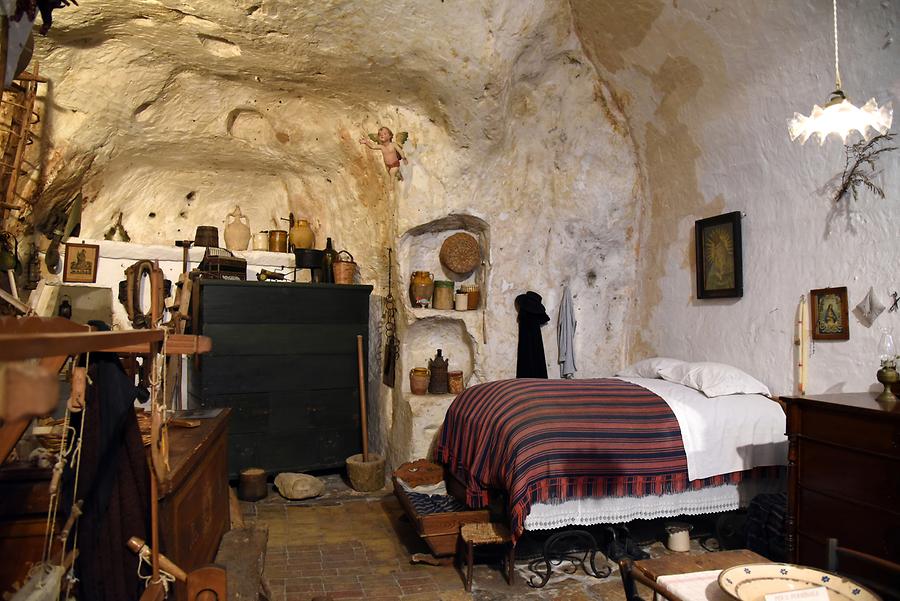Matera - 'Sasso'#

Matera - 'Sasso', April 2017, © Gerhard Huber, under CC BY-NC 4.0 +Edu
Bald schon entwickelten sich die Sassi zu Elendsquartieren für die bäuerliche Bevölkerung. In einer Wohnung von 25 m² lebten – ohne Fenster und Luftzirkulation - bis zu 15 Menschen mit ihren Haustieren. Die Exkremente bewahrte man in eigenen Behältern auf, um die geruchsintensive Fracht zum Gären zu bringen. Dieser Prozess erzeugte Wärme und heizte die Wohnhöhle in den kalten Wintermonaten. Die unerträglichen Zustände drangen erst 1945 mit dem Roman 'Christus kam nur bis Eboli' von Carlo Levi an die Öffentlichkeit. Der Schriftsteller berichtet über die Sassi von Matera: 'Ich sah in diese schwarzen Löcher mit Wänden aus Erde. Fliegenumschwärmt tauchten die Kinder auf, entweder nackt oder nur mit ein paar Lumpen bekleidet. Vor Hunger waren sie zu Skeletten abgemagert. Es wirkte auf mich, als wäre ich in der blendenden Sonne in eine von der Pest heimgesuchte Stadt geraten.' Die Beschreibung des Elends sorgte in ganz Italien für gehörigen Wirbel. In den 1950er Jahren wurden die unhygienischen Zustände in der Sassi zur 'nationalen Schande Italiens' erklärt und die Bewohner in eine am Hügel errichtete Neustadt umgesiedelt. Die Wohnhöhlen und mehr als 120 Felsenkirchen blieben ihrem Schicksal und dem Vandalismus überlassen. Die Wende kam 1993, als die Sassi Eingang in die Liste des UNESCO Weltkulturerbes fanden. Die Restauratoren machten sich ans Werk. Erste Touristen kamen. Hotels, Restaurants, Souvenirshops, Ateliers und Museen schossen wie Pilze aus dem Boden. Auch als Filmkulisse erlangte Matera Berühmtheit. Hollywood-Blockbuster wie die 'Passion Christi', das Remake des Horrorfilms 'Das Omen' oder die Neuverfilmung von 'Ben Hur' nutzten das Höhlenensemble als werbewirksamen Schauplatz. Heute präsentiert sich die Stadt sauberer, schöner und romantischer, als sie es vermutlich jemals war.
Soon the Sassi developed into slums for the peasant population. In an apartment of 25 m² lived - without windows and air circulation - up to 15 people with their pets. The excrements were kept in containers to ferment the odor-intensive content. This process generated heat and heated the cave dwelling during the cold winter months. These unbearable conditions got out only in 1945 with the novel 'Christ Stopped at Eboli' by Carlo Levi. The writer reports on the Sassi of Matera: 'I looked into those black holes with walls of earth. Beset with flies, the children appeared, either naked or wearing only a few rags. Starving, they were reduced to skeletons. It seemed to me as if I had come from the blinding sun into a plague-ridden city. The description of the misery caused quite a stir throughout Italy. In the 1950s, the unhygienic conditions in the Sassi were declared the 'national disgrace of Italy' and the inhabitants were rehoused to a new town built on the hill. The cave dwellings and more than 120 rock churches were abandonned to their fate and to vandalism. The turnaround came in 1993, when the Sassi were listed as a UNESCO World Heritage. The restorers set to work. The first tourists came. Hotels, restaurants, souvenir shops, studios and museums sprang up like mushrooms. Matera became famous even as a movie set: Hollywood blockbusters such as the 'Passion Christi', the remake of the horror movie 'The Omen' or the remake of 'Ben Hur' used the cave ensemble as a promotionally effective location. Today, the city is cleaner, more beautiful and more romantic than it probably ever was.